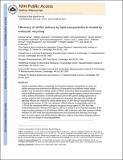Efficiency of siRNA delivery by lipid nanoparticles is limited by endocytic recycling
Author(s)
Sahay, Gaurav; Querbes, William; Alabi, Christopher A.; Eltoukhy, Ahmed A.; Sarkar, Sovan; Zurenko, Christopher; Karagiannis, Emmanouil; Love, Kevin T.; Chen, Delai; Zoncu, Roberto; Buganim, Yosef; Schroeder, Avi; Langer, Robert; Anderson, Daniel Griffith; ... Show more Show less
DownloadAnderson_Efficiency of.pdf (1.439Mb)
PUBLISHER_POLICY
Publisher Policy
Article is made available in accordance with the publisher's policy and may be subject to US copyright law. Please refer to the publisher's site for terms of use.
Terms of use
Metadata
Show full item recordAbstract
Despite efforts to understand the interactions between nanoparticles and cells, the cellular processes that determine the efficiency of intracellular drug delivery remain unclear. Here we examine cellular uptake of short interfering RNA (siRNA) delivered in lipid nanoparticles (LNPs) using cellular trafficking probes in combination with automated high-throughput confocal microscopy. We also employed defined perturbations of cellular pathways paired with systems biology approaches to uncover protein-protein and protein–small molecule interactions. We show that multiple cell signaling effectors are required for initial cellular entry of LNPs through macropinocytosis, including proton pumps, mTOR and cathepsins. siRNA delivery is substantially reduced as ≅70% of the internalized siRNA undergoes exocytosis through egress of LNPs from late endosomes/lysosomes. Niemann-Pick type C1 (NPC1) is shown to be an important regulator of the major recycling pathways of LNP-delivered siRNAs. NPC1-deficient cells show enhanced cellular retention of LNPs inside late endosomes and lysosomes, and increased gene silencing of the target gene. Our data suggest that siRNA delivery efficiency might be improved by designing delivery vehicles that can escape the recycling pathways.
Date issued
2013-06Department
Massachusetts Institute of Technology. Department of Chemical Engineering; Massachusetts Institute of Technology. Media Laboratory; Koch Institute for Integrative Cancer Research at MITJournal
Nature Biotechnology
Citation
Sahay, Gaurav, William Querbes, Christopher Alabi, Ahmed Eltoukhy, Sovan Sarkar, Christopher Zurenko, Emmanouil Karagiannis, et al. “Efficiency of siRNA Delivery by Lipid Nanoparticles Is Limited by Endocytic Recycling.” Nature Biotechnology 31, no. 7 (June 23, 2013): 653–658.
Version: Author's final manuscript
ISSN
1087-0156
1546-1696